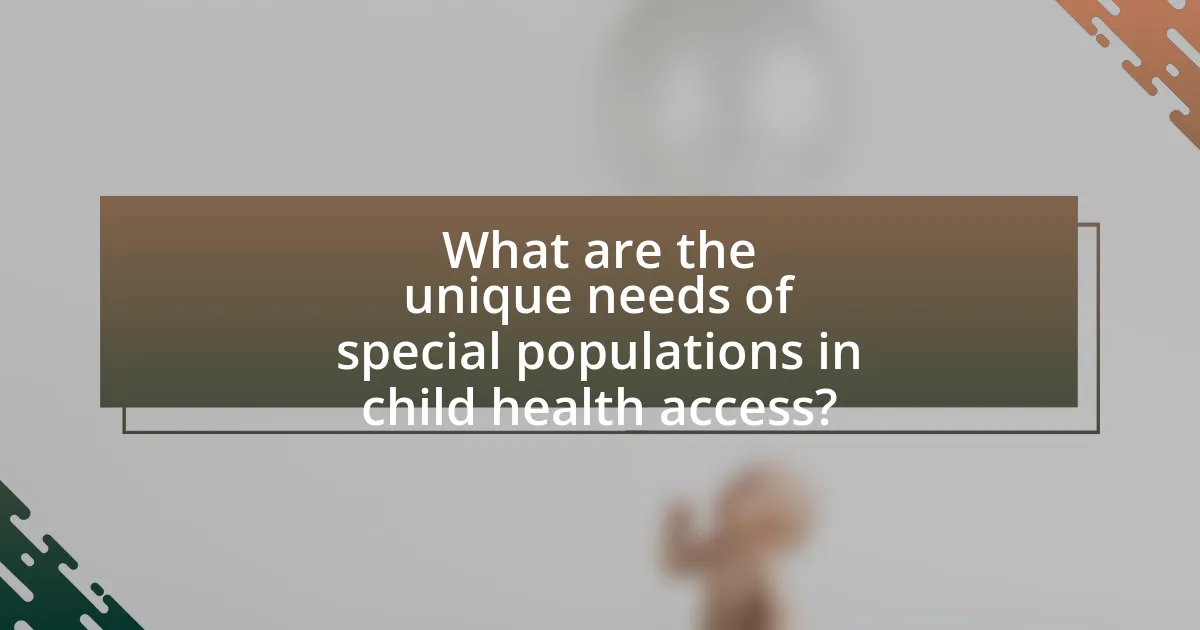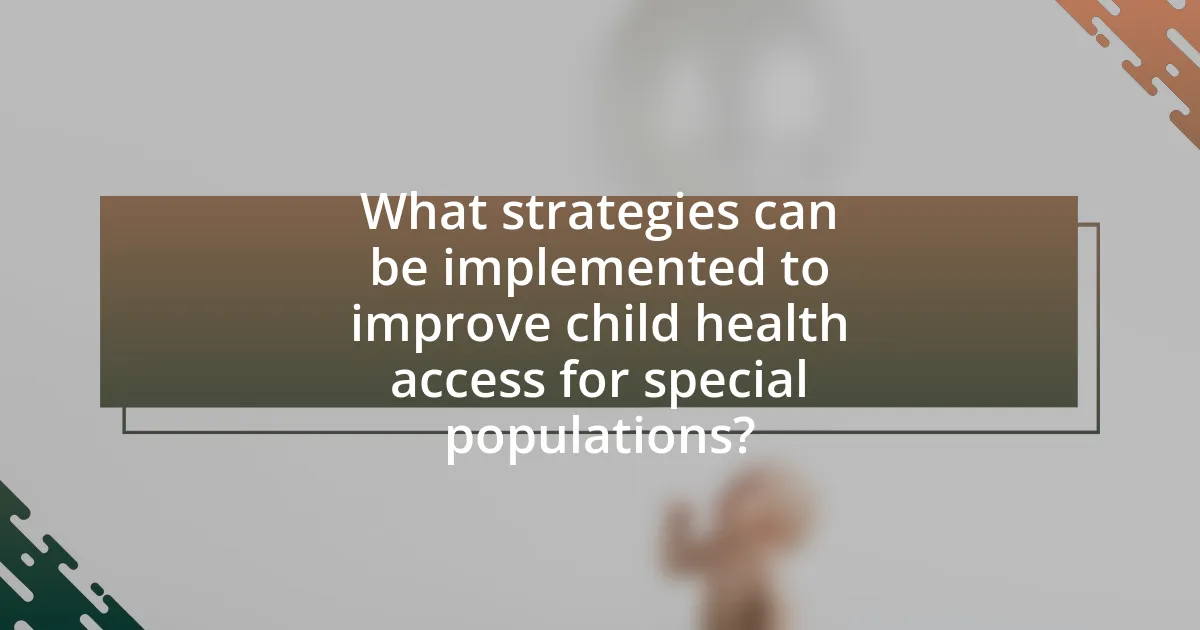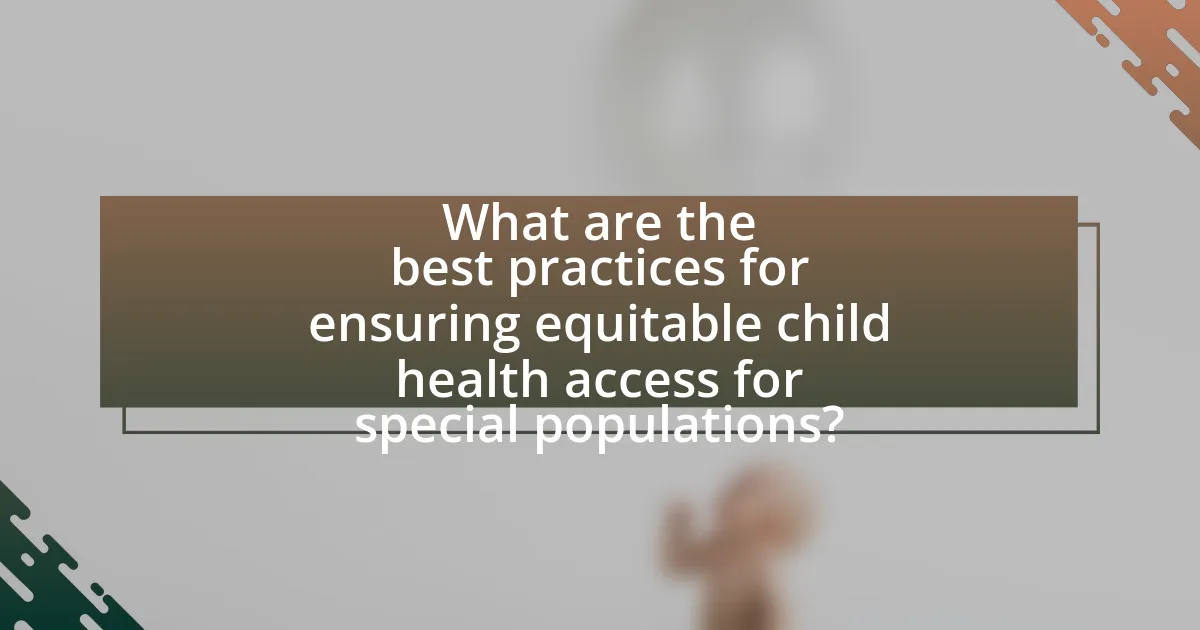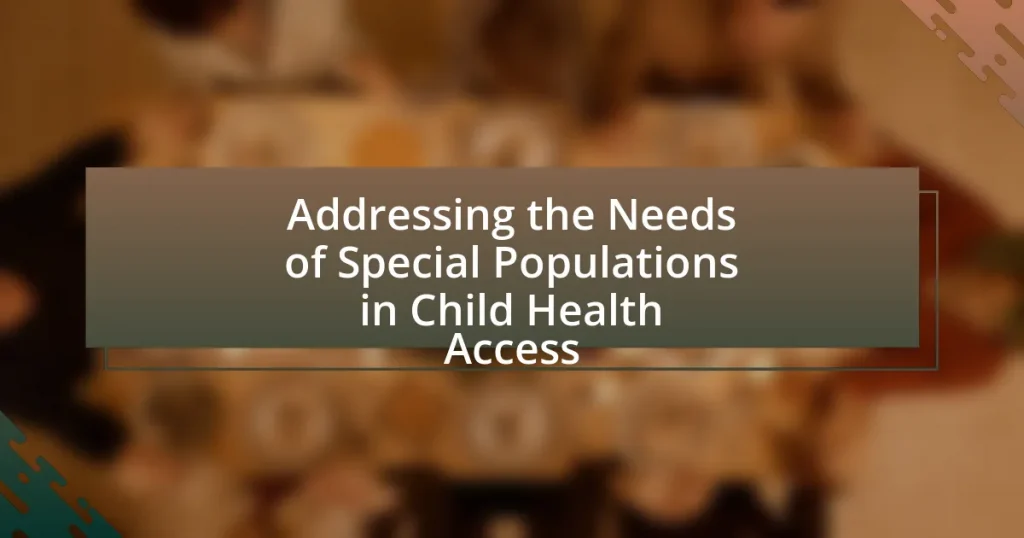The article focuses on addressing the unique needs of special populations in child health access, including children with disabilities, low-income families, and minority groups. It highlights the barriers these populations face, such as inadequate transportation, lack of insurance, and limited access to specialized care, which hinder timely healthcare services. The article discusses the impact of socioeconomic factors, geographic location, and cultural beliefs on health access, as well as the importance of implementing culturally competent care and community engagement strategies. Additionally, it emphasizes the role of policy and advocacy in improving health access and outlines best practices for enhancing healthcare delivery to ensure equitable outcomes for vulnerable children.

What are the unique needs of special populations in child health access?
Special populations in child health access, such as children with disabilities, those from low-income families, and minority groups, have unique needs that include tailored healthcare services, cultural competency, and financial assistance. These populations often face barriers like inadequate transportation, lack of insurance, and limited access to specialized care, which can hinder their ability to receive timely and appropriate health services. For instance, children with disabilities may require specific therapies and equipment that are not readily available in all healthcare settings, while low-income families may struggle to afford necessary treatments despite existing public health programs. Addressing these needs is crucial for improving health outcomes and ensuring equitable access to healthcare for all children.
How do socioeconomic factors impact child health access for special populations?
Socioeconomic factors significantly impact child health access for special populations by influencing the availability and quality of healthcare services. Families with lower income often face barriers such as lack of insurance, transportation issues, and limited access to healthcare facilities, which can lead to delayed or inadequate medical care for children. For instance, a study published in the American Journal of Public Health found that children from low-income families are more likely to experience unmet health needs compared to their higher-income counterparts, highlighting the disparities in access to necessary health services. Additionally, educational attainment among parents correlates with health literacy, affecting their ability to navigate the healthcare system effectively. Thus, socioeconomic status plays a crucial role in determining the level of health access and outcomes for children in special populations.
What specific challenges do low-income families face in accessing child health services?
Low-income families face significant challenges in accessing child health services, primarily due to financial constraints, lack of transportation, and limited availability of services. Financial constraints often result in the inability to afford co-pays, deductibles, or uninsured medical expenses, which can deter families from seeking necessary care. A study by the Kaiser Family Foundation found that 45% of low-income families reported cost as a barrier to accessing healthcare services. Additionally, lack of transportation can hinder access, as many families may not have reliable vehicles or public transport options to reach healthcare facilities. Furthermore, limited availability of services in underserved areas exacerbates these challenges, with many low-income families living in regions with few healthcare providers, leading to longer wait times and reduced access to specialized care.
How does geographic location influence health access for special populations?
Geographic location significantly influences health access for special populations by determining the availability of healthcare facilities, transportation options, and socioeconomic resources. For instance, rural areas often lack specialized healthcare services, leading to disparities in access for children with specific health needs. According to the National Rural Health Association, rural residents face higher rates of chronic conditions and lower access to preventive care compared to urban populations. Additionally, geographic barriers can exacerbate health inequities, as families in remote locations may have to travel long distances to receive necessary medical care, which can delay treatment and negatively impact health outcomes.
What role do cultural factors play in child health access for special populations?
Cultural factors significantly influence child health access for special populations by shaping perceptions, beliefs, and behaviors regarding healthcare. For instance, cultural beliefs may affect how families perceive illness and treatment, leading to either reluctance or willingness to seek medical care. Research indicates that language barriers, cultural stigma, and differing health practices can hinder access to necessary services, particularly for immigrant and minority populations. A study published in the Journal of Health Care for the Poor and Underserved found that culturally tailored health interventions improved access and utilization of services among diverse groups, demonstrating the importance of addressing cultural factors in healthcare delivery.
How can cultural beliefs affect health-seeking behaviors in special populations?
Cultural beliefs significantly influence health-seeking behaviors in special populations by shaping perceptions of illness, treatment, and healthcare systems. For instance, populations with strong traditional beliefs may prioritize alternative medicine over conventional healthcare, leading to delays in seeking necessary medical attention. Research indicates that cultural factors, such as trust in healthcare providers and understanding of medical practices, directly impact whether individuals engage with health services. A study published in the Journal of Health Care for the Poor and Underserved found that cultural mistrust can lead to lower utilization of preventive services among minority groups, highlighting the critical role of cultural beliefs in health-seeking behaviors.
What strategies can be employed to improve cultural competence in healthcare delivery?
To improve cultural competence in healthcare delivery, organizations can implement training programs focused on cultural awareness and sensitivity. These programs educate healthcare providers about diverse cultural practices, beliefs, and values, which enhances communication and trust with patients from various backgrounds. Research indicates that culturally competent care can lead to better patient outcomes; for instance, a study published in the Journal of Health Care for the Poor and Underserved found that culturally tailored interventions significantly improved health service utilization among minority populations. Additionally, integrating community health workers who share cultural backgrounds with patients can bridge gaps in understanding and foster more effective healthcare delivery.
Why is it important to address the needs of special populations in child health access?
Addressing the needs of special populations in child health access is crucial to ensure equitable healthcare outcomes. Special populations, including children with disabilities, chronic illnesses, or those from marginalized communities, often face barriers that hinder their access to necessary health services. For instance, studies show that children with disabilities are more likely to experience unmet healthcare needs compared to their peers, leading to poorer health outcomes. By focusing on these populations, healthcare systems can implement targeted interventions that improve access, reduce disparities, and promote overall child health.
What are the long-term consequences of inadequate health access for special populations?
Inadequate health access for special populations leads to chronic health disparities and increased morbidity. These populations, which often include low-income families, racial and ethnic minorities, and individuals with disabilities, experience higher rates of preventable diseases due to limited access to preventive care and treatment. For instance, studies show that children from underserved communities are more likely to suffer from conditions such as asthma and obesity, which can have lasting effects on their overall health and development. Furthermore, the lack of access to mental health services can result in long-term psychological issues, affecting educational outcomes and social integration. The cumulative effect of these health disparities can perpetuate cycles of poverty and inequality, as individuals with inadequate health access are less likely to achieve optimal educational and employment opportunities.
How does addressing these needs benefit the overall healthcare system?
Addressing the needs of special populations in child health access benefits the overall healthcare system by improving health outcomes and reducing long-term costs. When healthcare systems prioritize the unique requirements of vulnerable children, such as those from low-income families or with disabilities, they enhance early intervention and preventive care. This proactive approach leads to fewer emergency room visits and hospitalizations, ultimately lowering healthcare expenditures. For instance, studies show that investing in early childhood health initiatives can yield a return of up to $7 for every $1 spent, demonstrating the financial and health advantages of addressing these specific needs.

What strategies can be implemented to improve child health access for special populations?
To improve child health access for special populations, targeted outreach programs and culturally competent care must be implemented. These strategies ensure that healthcare services are accessible and relevant to diverse communities, addressing barriers such as language, transportation, and socioeconomic status. For instance, studies show that community health workers can effectively bridge gaps by providing education and resources tailored to specific cultural needs, leading to increased healthcare utilization among underserved populations. Additionally, integrating telehealth services has proven beneficial, as it allows families in remote areas to access specialists without the need for travel, thereby enhancing overall health outcomes.
How can community engagement enhance health access for special populations?
Community engagement enhances health access for special populations by fostering trust and collaboration between healthcare providers and the community. This engagement leads to tailored health services that address specific needs, as evidenced by initiatives like the Community Health Worker model, which has shown to improve health outcomes in underserved populations by 30% through culturally relevant outreach and education. Additionally, community engagement facilitates the identification of barriers to access, allowing for the development of targeted interventions that can reduce disparities in health access.
What are effective methods for involving families in health program development?
Effective methods for involving families in health program development include conducting focus groups, utilizing surveys, and establishing family advisory boards. Focus groups allow families to share their experiences and insights directly, fostering a collaborative environment. Surveys can gather quantitative data on family needs and preferences, ensuring that programs are tailored to specific populations. Family advisory boards provide ongoing input and feedback, ensuring that family perspectives are integrated into program planning and implementation. Research shows that programs incorporating family input are more successful in meeting the needs of children and their families, as evidenced by studies indicating improved health outcomes and increased satisfaction among participants.
How can partnerships with local organizations improve outreach efforts?
Partnerships with local organizations can significantly enhance outreach efforts by leveraging their established community trust and networks. Local organizations often have deep-rooted connections and insights into the specific needs of special populations, which can inform targeted outreach strategies. For instance, a study published in the Journal of Community Health found that collaborations between healthcare providers and local nonprofits increased access to health services by 30% among underserved populations. This demonstrates that local organizations can facilitate better communication, increase awareness, and ultimately improve health outcomes by tailoring outreach initiatives to the unique cultural and social contexts of the communities they serve.
What role does policy play in improving child health access for special populations?
Policy plays a critical role in improving child health access for special populations by establishing frameworks that ensure equitable healthcare services. Effective policies can mandate the allocation of resources, enhance funding for targeted programs, and create regulations that protect the rights of vulnerable groups, such as children with disabilities or those from low-income families. For instance, the Children’s Health Insurance Program (CHIP) has significantly increased access to healthcare for millions of children in families with incomes too high to qualify for Medicaid but too low to afford private coverage, demonstrating how policy can directly impact health access. Additionally, policies that promote culturally competent care and address social determinants of health can further reduce barriers faced by special populations, ensuring that all children receive the necessary healthcare services.
What policies have been successful in enhancing health access for these groups?
Policies such as the Children’s Health Insurance Program (CHIP) and Medicaid expansion have been successful in enhancing health access for special populations, including low-income children and families. CHIP provides health coverage to uninsured children in families with incomes too high to qualify for Medicaid but too low to afford private coverage, significantly increasing access to preventive care and treatment. According to the U.S. Department of Health and Human Services, enrollment in CHIP has led to a reduction in the uninsured rate among children by over 50% since its inception. Additionally, Medicaid expansion under the Affordable Care Act has improved access to health services for low-income families, with studies indicating that states that expanded Medicaid saw a 7% increase in health care access among children. These policies demonstrate a direct correlation between targeted health initiatives and improved health outcomes for vulnerable populations.
How can advocacy efforts influence policy changes for better health access?
Advocacy efforts can significantly influence policy changes for better health access by mobilizing public support, raising awareness, and providing evidence-based recommendations to policymakers. For instance, organizations like the American Academy of Pediatrics have successfully advocated for policies that expand Medicaid coverage, resulting in increased access to healthcare services for children from low-income families. Research shows that advocacy campaigns can lead to legislative changes, such as the Children’s Health Insurance Program (CHIP), which was established to provide health coverage to millions of children who would otherwise be uninsured. These efforts demonstrate how targeted advocacy can effectively shape health policy to address the needs of special populations, ensuring equitable access to healthcare resources.
What technological solutions can aid in addressing health access needs?
Telehealth platforms are a key technological solution that can significantly improve health access needs. These platforms enable remote consultations between healthcare providers and patients, reducing barriers such as transportation and geographical limitations. According to a study published in the Journal of Medical Internet Research, telehealth services increased access to care for underserved populations by 50%, demonstrating their effectiveness in bridging gaps in healthcare access. Additionally, mobile health applications facilitate health education and management, empowering patients to take charge of their health and connect with resources.
How can telehealth services improve access for special populations?
Telehealth services can improve access for special populations by providing remote healthcare options that eliminate geographical and mobility barriers. For instance, individuals in rural areas or those with disabilities can receive timely medical consultations without the need for travel, which is often a significant obstacle. A study published in the Journal of Telemedicine and Telecare found that telehealth increased access to care for underserved populations by 50%, demonstrating its effectiveness in reaching those who might otherwise face challenges in accessing traditional healthcare services.
What are the barriers to technology adoption in healthcare for these groups?
Barriers to technology adoption in healthcare for special populations include limited access to resources, lack of digital literacy, and concerns about data privacy. Limited access to resources often results from socioeconomic factors, where families may not have the necessary devices or internet connectivity to utilize healthcare technologies effectively. Lack of digital literacy can hinder the ability of caregivers and patients to navigate health technology platforms, which is critical for managing health information and services. Additionally, concerns about data privacy and security can create distrust in technology, leading to reluctance in its adoption. According to a study published in the Journal of Medical Internet Research, these barriers significantly impact the engagement of underserved populations in digital health initiatives, highlighting the need for targeted interventions to address these challenges.

What are the best practices for ensuring equitable child health access for special populations?
Best practices for ensuring equitable child health access for special populations include implementing culturally competent care, enhancing community engagement, and utilizing data-driven approaches to identify and address disparities. Culturally competent care involves training healthcare providers to understand and respect diverse cultural backgrounds, which has been shown to improve health outcomes for minority populations. Community engagement fosters trust and collaboration between healthcare systems and special populations, leading to tailored health interventions that meet specific needs. Data-driven approaches, such as the use of health equity assessments, help identify gaps in access and inform policy decisions, ensuring resources are allocated effectively to underserved groups. These practices collectively contribute to reducing health disparities and improving overall child health access.
How can healthcare providers improve their approach to special populations?
Healthcare providers can improve their approach to special populations by implementing culturally competent care practices. Culturally competent care involves understanding and respecting the diverse backgrounds, beliefs, and needs of patients, which can enhance communication and trust. Research indicates that culturally competent care can lead to better health outcomes; for instance, a study published in the American Journal of Public Health found that culturally tailored interventions significantly improved health service utilization among minority populations. By training staff in cultural competence and employing diverse healthcare teams, providers can better address the unique challenges faced by special populations, ultimately leading to more effective and equitable healthcare delivery.
What training is necessary for healthcare providers to better serve special populations?
Healthcare providers require cultural competency training to better serve special populations. This training equips providers with the skills to understand and respect diverse cultural backgrounds, beliefs, and practices, which is essential for effective communication and patient care. Studies indicate that culturally competent care can lead to improved health outcomes and patient satisfaction, as it fosters trust and reduces disparities in healthcare access. For instance, the National Institutes of Health highlights that training in cultural awareness can significantly enhance the quality of care for minority populations, thereby addressing their unique health needs.
How can providers create a welcoming environment for diverse families?
Providers can create a welcoming environment for diverse families by implementing culturally competent practices and fostering inclusive communication. Culturally competent practices involve understanding and respecting the unique backgrounds, languages, and values of each family, which can be achieved through staff training and community engagement. Inclusive communication ensures that families feel heard and valued, which can be facilitated by offering translation services and employing staff who reflect the community’s diversity. Research indicates that healthcare settings that prioritize cultural competence see improved patient satisfaction and engagement, as evidenced by a study published in the Journal of Health Care for the Poor and Underserved, which found that culturally tailored interventions significantly enhance access to care for diverse populations.
What resources are available to support special populations in accessing child health services?
Resources available to support special populations in accessing child health services include community health centers, Medicaid programs, and specialized outreach initiatives. Community health centers provide comprehensive services regardless of insurance status, ensuring that low-income families receive necessary care. Medicaid programs offer coverage for eligible children, including those with disabilities, which facilitates access to essential health services. Specialized outreach initiatives, such as the Children’s Health Insurance Program (CHIP), target uninsured children in families with incomes too high to qualify for Medicaid, thereby expanding access to health services for special populations. These resources collectively enhance the ability of vulnerable groups to obtain necessary child health services.
What community resources can assist families in navigating health systems?
Community resources that assist families in navigating health systems include patient navigators, community health workers, and local health advocacy organizations. Patient navigators provide personalized support to help families understand healthcare options, schedule appointments, and access services. Community health workers often serve as liaisons between families and healthcare providers, offering education and assistance in overcoming barriers to care. Local health advocacy organizations, such as the National Association of Community Health Centers, provide resources and information tailored to specific populations, ensuring families receive the necessary guidance to effectively navigate complex health systems.
How can families be educated about their health rights and available services?
Families can be educated about their health rights and available services through community outreach programs, workshops, and informational resources. These initiatives often provide tailored information that addresses specific health rights, such as access to care, informed consent, and confidentiality. For instance, organizations like the American Academy of Pediatrics offer resources and training for families to understand their rights and navigate healthcare systems effectively. Additionally, local health departments frequently conduct educational sessions that inform families about available services, ensuring they are aware of resources such as Medicaid, CHIP, and community health clinics.
What practical steps can be taken to enhance child health access for special populations?
To enhance child health access for special populations, implementing targeted outreach programs is essential. These programs can include mobile health clinics that reach underserved areas, providing vaccinations and health screenings directly to children in need. Research indicates that mobile clinics can significantly increase access to healthcare services, particularly in rural and low-income urban areas, where traditional healthcare facilities may be lacking. Additionally, training healthcare providers to understand the unique needs of special populations, such as children with disabilities or those from diverse cultural backgrounds, can improve the quality of care and ensure that services are culturally competent and accessible.
What are the key considerations for developing targeted health programs?
Key considerations for developing targeted health programs include understanding the specific needs of the population, ensuring cultural competence, and utilizing data-driven approaches. Understanding the specific needs involves conducting thorough assessments to identify health disparities and barriers faced by the target group, which can be supported by studies showing that tailored interventions significantly improve health outcomes. Cultural competence ensures that programs are respectful and relevant to the beliefs and practices of the population, as evidenced by research indicating that culturally tailored health programs increase engagement and effectiveness. Utilizing data-driven approaches involves analyzing health data to inform program design and implementation, which is crucial for measuring impact and adjusting strategies based on outcomes.
How can ongoing evaluation improve health access initiatives for special populations?
Ongoing evaluation can significantly enhance health access initiatives for special populations by identifying barriers and tailoring services to meet specific needs. Continuous assessment allows stakeholders to gather data on the effectiveness of interventions, ensuring that resources are allocated efficiently and that programs are responsive to the evolving challenges faced by these populations. For instance, a study published in the American Journal of Public Health found that regular feedback mechanisms improved service delivery and patient satisfaction among underserved communities, demonstrating the importance of adaptive strategies in health initiatives.
